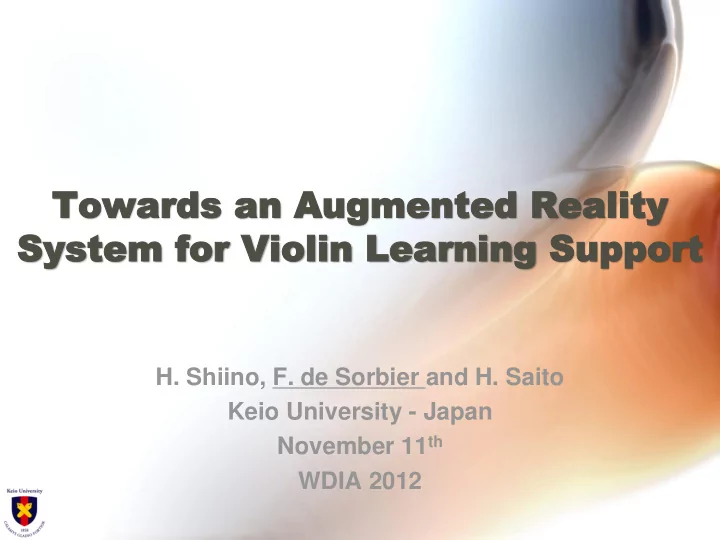

Towards an Towards an Augment Augmented Reality ed Reality System for Violin Learning System for Violin Learning Support Support H. Shiino, F. de Sorbier and H. Saito Keio University - Japan November 11 th WDIA 2012
Motivat Motivation ion • Violin is one of the most difficult instrument – No fret on the fingerboard – Manipulation of the bow
Previous works ( Previous works (1) 1) • MusicJacket – Advices using vibro-tactile feedbacks – Works only for the bowing arm van der Linden, J., Schoonderwaldt, E. and Bird, J. “Good Vibrations: Guiding Body Movements with Vibrotactile Feedback”. Proceedings of the Third International Workshop on Physicality , 13-18, 2009
Previous works ( Previous works (2) 2) • Guitar playing support – AR toolkit markers for tracking the fingerboard – Display a virtual hand for advising the finger position Y. Motokawa, H. Saito. “Support system for guitar playing using augmented reality display”. In Proceedings of the 5th IEEE and ACM ISMAR , 243-244, 2006
Our goal (1) Our goal (1) • Display virtual frets and visual guides on the screen Require to estimate the pose of the violin
Our goal (2) Our goal (2) • Teach the correct position of the bowing arm Require to track the player’s bowing arm
Pose Pose estimation estimation without marker without marker • Using a feature detector – Many occlusions caused by the player – The surface of the violin has a poor texture – The material of the violin is highly specular Using feature detection is not robust
Our approac Our approach • Kinect for estimating the pose of the violin • Also used for tracking the player • Feedback displayed onto a screen
Our sys Our system tem workflow workflow 1. Offline phase: build a 3D model of the violin with AR references 2. Online phase: pose estimation and feedback
Pose estimation Pose estimation with I with ICP CP • Iterative Closest Point algorithm – Slow if too many points – Inaccurate if not enough • Proposed solution – Use several template for describing the reference model – Associate a plane equation for describing a violin template – Construct a 3D model from templates for AR datas – Detect the violin in the color image – Estimate the pose between the current point cloud and one given template
Segmentation of the violin Segmentation of the violin • Segment the violin based on its color • From corresponding 3D points – Compute a plane equation – Create a 3D box along and centered on it – Refine the segmentation
Storage of the template Storage of the templates • Add a new template when candidate is enough different from stored ones • Compute the final 3D model
Online tracking of the violin Online tracking of the violin • Same segmentation than in the offline stage • Deduce the corresponding template by comparing plane equations • Compute the rigid transformation Rt by applying the ICP algorithm • Display virtual advices on the captured model defined based on the pre-computed model
Violin tracking Violin tracking result result
Virtua Virtual l Frets Frets on the violin on the violin • Virtual information associated with the pre-computed 3D model • Transform the captured violin to the pose of the 3D model – Computed with the result of the tracking – Result displayed in a stable manner
Fingering and bo Fingering and bow w advices advices • Analysis of the note played – A fret and a string highlighted – Advise on the position of the bow
About About the bowing t the bowing technique echnique • Follow movements of a scaled and aligned captured movement
Resu Results lts • Processing time: 21ms • About the tracking Rx(deg) Ry(deg) Rz(deg) T(mm) Minimum error 0.12 0.25 0.20 0.22 Maximum error 13.29 8.27 7.89 32.1 Average error 3.07 2.69 2.78 7.20 • Difference of Pitch Fret number 1 2 3 4 5 6 7 8 9 average Difference of 11.1 14.1 12.0 12.4 13.4 15.8 12.8 13.9 19.2 13.8 pitch
Conclus Conclusions ions • Violin pedagogy with augmented reality using Kinect – Real time tracking of the violin and the player – Display virtual frets and strings – Detect the note played – Advise on position of the bow and the position of the bowing arm
Future works Future works • Perform an evaluation with different kind of players • Study about another visualization option – See-through HMD • Extension to other string instruments – sanshin
Questions Questions? Thank you for your attention
Recommend
More recommend